This Budget, Let's Make HOPE Truly Count
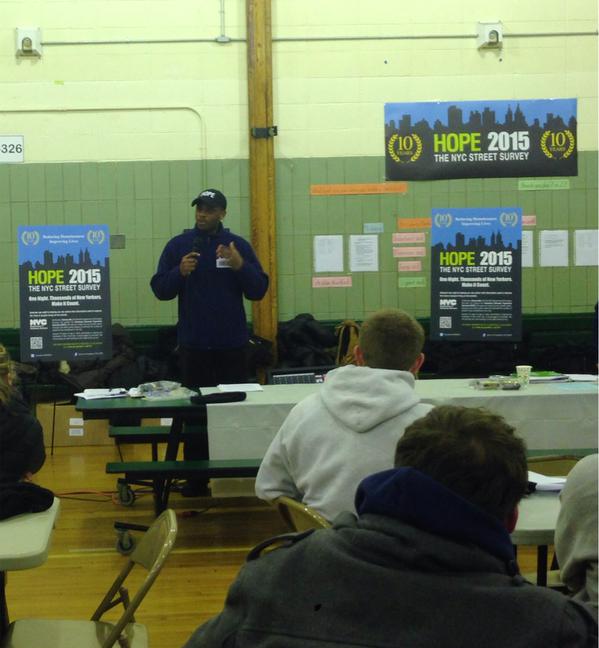
DHS Commissioner Taylor during HOPE 2015 (photo: @JennsLenz)
Last Monday night, thousands of volunteers spanned across New York City to conduct Homeless Outreach Prevention Estimate (HOPE) 2015. HOPE is the annual point-in-time count of the New York City street homeless. It enables the City to gauge the extent of street homeless in New York City – an estimated 3,357 individuals last year. HOPE also helps the City to evaluate the ongoing street homelessness work it and its nonprofit partners are doing, including outreach.
Outreach work has two components. First, workers attempt to engage the street homeless individual, who is often living with a mental illness, substance abuse issue, or severe health problem.
"You introduce yourself, give them your card and ask them if there's anything they need," says Hilton Douglas, an Urban Pathways outreach worker. "Sometimes they tell us to get out of their face, but you just have to keep engaging with them day in and day out. Other times you catch them at the right time and with the right tone, and they open up."
On day one of Port Authority Bus Terminal outreach work this past September, Urban Pathways staff engaged Mark H. His body was covered with open sores, including some on his left leg infested with maggots. When outreach approached him, he insisted he did not need help. After outreach workers found him 24 hours later, he agreed to go to the Olivieri Drop-In Center where he got a shower and new clothes and met with a nurse. He also agreed to go to the hospital where he was diagnosed as a paranoid schizophrenic.
The second important component of outreach work is placement. For Mark H, placement was a return home to his family. After initial assessment, Olivieri staff discovered he was the subject of a six-month, Ohio missing person report. Once staff contacted the local Ohio sheriff office and Mark H was stabilized, his brother came and took him home.
The placement that occurred for Mark H is infrequent though. More often, street homeless individuals are placed in drop-in centers or city single adult shelters. There, with the invaluable assistance of case managers, they stabilize and work to become housing-ready and move along the path to self-sufficiency and permanent housing.
However, many homeless adults living on the streets are unwilling to enter the city shelter system. They fear they will be victimized. Or, they may be seriously impaired due to mental illness or substance abuse and unable to commit to treatment or recovery as a condition to accessing shelter. For this chronically homeless population, the City offers safe havens, which operate using the housing first model – an approach that centers on providing the homeless with housing as quickly as possible and then providing services as needed.
Safe havens constitute a particularly viable placement option. Beside providing shelter and services, they allow for a transitional period to begin the rehabilitative process and recovery from the harshness of the streets. New York City has recognized the utility of safe havens. There are ten in four boroughs - three in the Bronx, four in Manhattan, two in Brooklyn, and one on Staten Island.
Another key service model in addressing street homelessness is supportive housing - affordable housing combined with support services tailored to individual needs. Supportive housing has proved effective. In the first five years of the most recent New York City/State supportive housing agreement, New York City chronic homelessness decreased by almost half. The utility of supportive housing, in part, stems from the stabilization it provides to those who have lived extremely unstable lives. However, there is a dearth of supportive housing in New York City. Only one supportive housing unit is available for every six eligible individuals. At least two-thirds of New York City street homeless are in need of permanent supportive housing.
As the City and State move forward in budget season, let's make HOPE truly count by adequately investing in these placement options. It is encouraging that the City will devote more resources to unsheltered homeless people this year, allocating more than $45 million in City and State funds, up from $35.5 million the year before. It is less than encouraging that the City and State have not adopted a new City/State supportive housing agreement. In particular, we call on the State, notably Governor Cuomo, to amend the proposed state budget and fully fund the State's share of a New York City/State supportive housing agreement. The time is now to account for and support all those counted during this year's HOPE and those before.
***
by Nicole Bramstedt and Erik Ipsen
Bramstedt is the Policy Analyst at Urban Pathways.
Ipsen is a member of the Board of Urban Pathways, where he has served since 2002.
***
Have an op-ed idea or submission for Gotham Gazette? E-mail editor Ben Max: This email address is being protected from spambots. You need JavaScript enabled to view it.
Moving Forward in Sunset Park
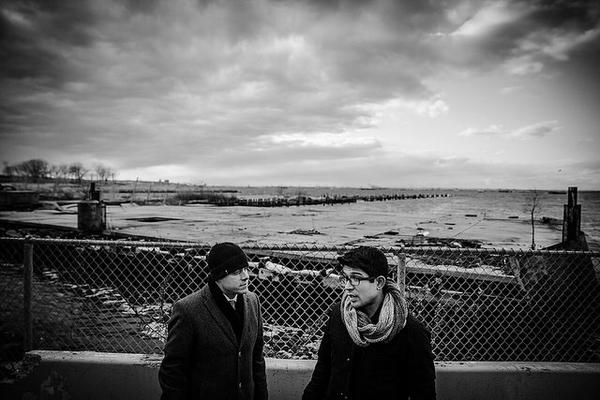
CMs Garodnick, left, and Menchaca visit the site in question (photo: William Alatriste)
Mayor Bill de Blasio's mantra around addressing the "Tale of Two Cities" that is New York particularly resonates in Sunset Park, Brooklyn. It is one of the city's few remaining industrial waterfront neighborhoods with a high concentration of working-class and poor residents, mostly immigrants from Asia and Latin America. However, the growing presence of the creative class including fashion designers and artisanal manufacturers has stirred concerns of gentrification and displacement among long-time residents and community stakeholders.
Make no mistake, Sunset Park is at a crossroads. The industrial waterfront is changing through private and public investment after long years of neglect. But if the tale of two cities is to be truly tackled, the waterfront's renaissance needs to be inclusive.
Measures must be taken to ensure that long-time residents and businesses are not forced out due to rising property values triggered by the introduction of affluent millennials as Sunset Park entrepreneurs and residents. The de Blasio Administration must recognize that creating jobs with living wages is as essential as affordable housing.
Toward that end, it might be instructive for the administration to revisit the de Blasio mayoral campaign's ideas. Mayor de Blasio was one of the few candidates to specifically articulate an industrial attraction and retention policy, doing so in a paper titled, "A Progressive Vision for Industrial Development in New York City."
Recognizing the need for blue-collar jobs and manufacturing's high annual wages in comparison to the retail or food service industries (two of the city's fastest growing job sectors), candidate de Blasio pointed to the Brooklyn Navy Yard and the Greenpoint Manufacturing Design Center as "models for non-profit industrial development" that create good jobs. In the same paper, he specifically proposed that Sunset Park's Brooklyn Army Terminal and Bush Terminal - two massive industrial sites managed by the New York City Economic Development Corporation (EDC) - "would benefit from an independent non-profit manager dedicated to strategic investment, workforce development, and reinvestment into the target area." [italics added]
Sunset Park City Council Member Carlos Menchaca seems to have read the same policy paper when he proposed the formation of such a non-profit entity to act as a steward for the South Brooklyn Marine Terminal (SBMT) rather than signing away control of the 70-plus-acre site to the EDC for the next half-century.
EDC's chief, a mayoral appointee, called off the deal claiming "it's not good public policy" in the New York Daily News and described the proposal as "confounding" in Crain's New York.
We're puzzled by the EDC's actions. We grew up in Sunset Park and our father continues to live in the same house he's called home since 1974. Both of our parents labored in industrial, manufacturing jobs. We wholeheartedly support Mayor de Blasio's commitment to ensuring that the same opportunities our family had remain available for all New Yorkers.
In his State of the City speech, Mayor de Blasio stated that "[c]reating more affordable housing; raising wages and benefits; strengthening our neighborhoods by better connecting them to jobs and opportunity—that is how we'll take on the Tale of Two Cities." Now is the time to move this vision forward and candidate de Blasio proposed a way to do so in Sunset Park.
***
by Tarry and Carl Hum
Tarry Hum is a professor at the City University of New York and author of Making a Global Immigrant Neighborhood: Brooklyn's Sunset Park
Carl Hum is a civil rights attorney in Washington D.C. and former director of the New York City Mayor's Office of Industrial and Manufacturing Businesses
***
Have an op-ed idea or submission for Gotham Gazette? E-mail editor Ben Max: This email address is being protected from spambots. You need JavaScript enabled to view it.
Labor Supports a Fair Trash Plan
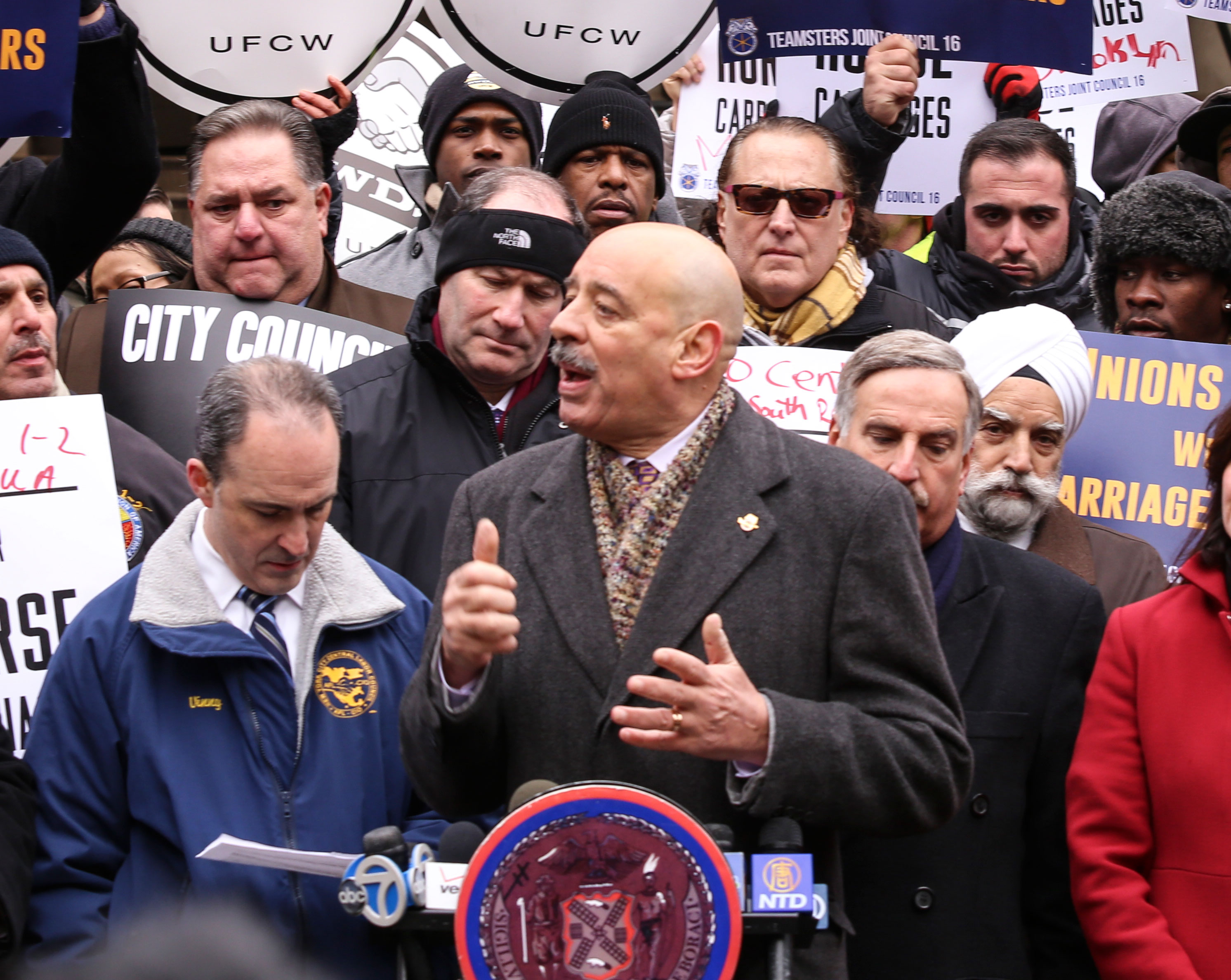
George Miranda, the author, at a rally (photo via International Brotherhood of Teamsters)
There are few things more political in New York City than garbage.
On Friday, the City Council's Sanitation Committee held a hearing on Intro. 495, legislation that will cap the amount of trash that can be sent to any one neighborhood for disposal.
It sounds simple enough and only fair. But fights between communities and big corporations, who make a lot of money hauling garbage, are rarely easy. Intro. 495 is a different story. Labor is standing shoulder-to-shoulder with these communities and holding the companies where our members work accountable.
The Teamsters are New York City's sanitation union. From the Department of Sanitation workers who pick up the trash and recycling from your home, to the private carting workers who collect and process waste from New York City businesses, we take out the trash.
In the past, unions did not see community activists as our allies – or worse, we saw them as Not-In-My-Backyarders standing in the way of jobs. I now know that these fights are our fights too. Caring about workers does not end when they clock out. If our members do not have clear air to breathe or safe streets to walk with their kids, that is a union issue.
It is also about fundamental fairness. Forcing a few neighborhoods to take almost all of the city's trash is just plain wrong.
Currently, three-quarters of New York City's trash is sent to three communities: the South Bronx, North Brooklyn, and Southeast Queens. Almost half of our city's trash comes from Manhattan, but the borough lacks a single transfer station, the facilities where garbage is dumped every day and loaded onto trucks destined for out-of-state landfills.
The Department of Sanitation plans to change that with a state-of-the-art transfer station on East 91st Street, and others around the city. Technology will control odors and pollution, and trash will be exported by barge and rail, reducing the number of trucks on our streets. The employees will join the ranks of the city's sanitation workers, Teamster members who receive good pay, benefits, and safety protections.
The South Bronx, where I grew up, is home to numerous dirty, old waste transfer stations. Every morning, long lines of private garbage trucks form in front of homes, schools, and parks, waiting to drop off their loads. The smell is even worse than the sight – garbage fumes and diesel exhaust – and the problem is more than aesthetic. Children in these communities have higher asthma rates than the city as a whole because of pollution like diesel exhaust.
It's not a coincidence that neighborhoods like the South Bronx get saddled with all of our waste. The sanitation corporations have always found it easier to operate in poor communities of color. Our city government has gone along with it.
Mayor de Blasio and the City Council can do better. Voters want elected officials who will make sure the trash gets picked up, but we also voted for a vision of one city, where the poorest and most vulnerable among us are protected.
Intro. 495 would do two things. It would reduce the amount of trash going to the three most burdened neighborhoods. They would still take more trash than anywhere else, but the impact would be lessened. This has been the goal of opening a fleet of modern transfer stations, which will soon come on line around the city, but this legislation would make it the law too.
Second, the legislation would create a cap for all communities, so that no neighborhood ever again takes more than its fair share of trash.
Intro. 495 is part of a larger movement to make a waste system that works for everyone. At the same time, we are working to increase recycling, expand composting, and raise working standards in the sanitation industry.
You might be asking yourself, why would the sanitation workers union want to reduce the amount of trash we collect? The truth is, this is an industry where becoming more efficient actually creates more and better jobs. Recycling creates five to 20 times more jobs than landfilling trash. By increasing recycling we won't just be cleaning up our communities, we will also be creating good jobs for New York families.
Less trash is better for New Yorkers, at home and at work.
***
George Miranda is President of Teamsters Joint Council 16.
***
Have an op-ed idea or submission for Gotham Gazette? E-mail editor Ben Max: This email address is being protected from spambots. You need JavaScript enabled to view it.
Pass Nicholas' Law, Increase Protection for Children from Guns
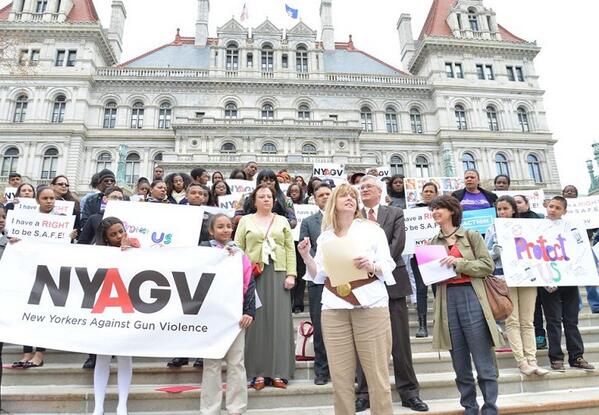
A NYAGV rally in Albany (photo: @NYAGV1)
On December 22, 2010, Oxsana Naumkin received a phone call no parent should ever get. She was told, "Nicholas has been shot." Her 12-year-old son, Nicholas, had been fatally shot while on a playdate by a friend who found his father's loaded and unlocked 9mm handgun in a dresser drawer.
The adult responsible received a $250 fine and was ordered to surrender his weapons.
According to federal data from the Centers for Disease Control, between 2007 and 2013 an average of 62 children aged 14 and under died each year in unintentional shootings. But a 2014 study by Everytown for Gun Safety shows these deaths are significantly undercounted. The study revealed that at least 100 children were killed in unintentional shootings from December 2012 to December 2013 - almost 2 children per week and 61% more than federal data show. Nearly 85% of these deaths happened in a home or vehicle belonging to the family, a friend, or relative of the victim, as in the case of Nicholas Naumkin, most often with guns that were legally owned but not locked up.
As well as being killed, children are often unintentionally injured by guns. In New York State an average of 210 children aged 19 and under are treated annually in a hospital because of an unintentional firearm injury.
Although the shooting death of Nicholas Naumkin was called an 'accident' by the media, where children and guns are involved, there is no such thing as an accident.
These deaths and injuries are preventable. We protect our children from household poisons, secure them in car seats and with seat belts, install stair guards, child-proof light sockets, and fence in our swimming pools. Shouldn't we also be concerned about a product owned by 30% of American households that was designed to kill?
Nearly two million children live with unsecured guns. In New York, 38% of gun owners reported some form of unsafe storage.
Many parents underestimate the extent to which their children know where guns are stored and how often their children handle these guns without adult supervision. A Harvard study showed that 70% of children under the age of 10 know where a parent keeps the household gun and 36% of the children reported handling the weapon.
The American Academy of Pediatrics (AAP) strongly advises homes with kids to be gun free. That's because a gun in the home is far more likely to kill someone known to the family than to kill or injure an intruder.
A gun in the home also triples the risk of homicide and increases the risk of suicide by 5 times. If parents or caregivers do own a gun, the AAP urges the adults to be responsible and lock them up, separate from the ammunition, so children can't gain access.
Unsecured guns in the home also contribute to youth suicides. Nationally, suicides in children and youth from the ages of 10–19 hit a twelve-year high in 2013. Gun suicides are now the second leading cause of death among children and teens after car deaths, replacing gun homicides. Sixteen New York children and teens committed suicide with a gun in 2013.
Educating parents about safe gun storage is important. Before they send their child to another home, parents should ask, "Is there an unlocked gun in your house?" Oxsana Naumkin is convinced had she asked this question, Nicholas may still be alive.
But safe storage laws are also important. There is strong evidence that Child Access Prevention (CAP) Laws can reduce the number of children killed or injured in unintentional shootings and significantly reduce youth suicides. CAP laws make gun owners, whose unsecured guns result in harm, subject to criminal liability.
Twenty-eight states and the District of Columbia have some form of safe storage law. Many people may be surprised to learn that New York, a state with relatively strong gun safety laws, does not have a Child Access Prevention law. Even Texas and Florida have CAP laws.
That's why New Yorkers Against Gun Violence is advocating for Nicholas' Law (A.53/S.2291), named for Nicholas Naumkin. The law would require guns not in the immediate possession of the owner to be stored in a safe or other secure container with a locking device, to prevent access by children. Gun owners who fail to comply will be subject to criminal liability ranging from a violation to a felony, depending on the harm that results.
The New York State Coalition to Prevent Child Access to Guns is calling for the enactment of Nicholas' Law and has over fifty member organizations, including the American Academy of Pediatrics, the NY State Nurses Association, the NY State PTA, the League of Women Voters, and the NY State Chapter of Moms Demand Action for Gun Sense in America.
New York must do everything it can to protect children from the dangers of unsecured guns in the home.
***
Leah Gunn Barrett is the Executive Director of New Yorkers Against Gun Violence
Sign the petition for Nicholas' Law at www.nyagv.org. Your organization can join the NY State Coalition to Prevent Child Access to Guns by emailing This email address is being protected from spambots. You need JavaScript enabled to view it.
***
Have an op-ed idea or submission for Gotham Gazette? E-mail editor Ben Max: This email address is being protected from spambots. You need JavaScript enabled to view it.
Queens Deserves Better Transportation
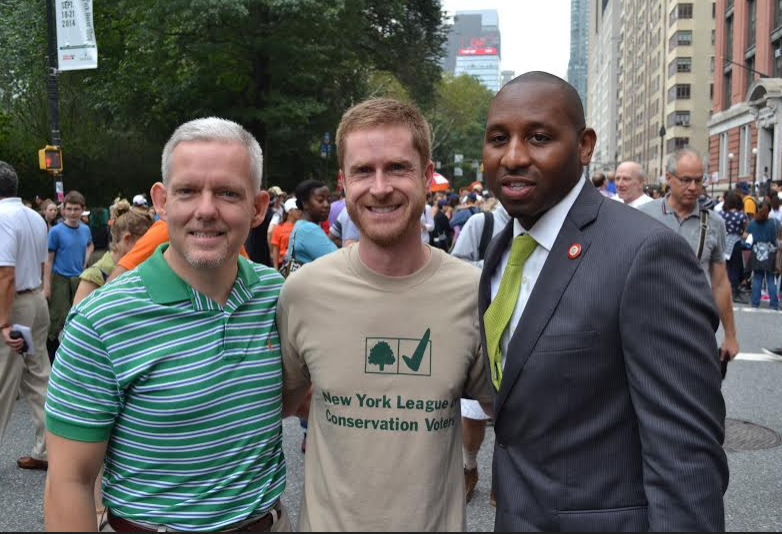
Council Members Van Bramer, left, and Rchards, right, flank an advocate
When Rockaway Peninsula's only subway connection to Manhattan – the A Train – was not in service for seven months after Hurricane Sandy, it shined a bright light on the inadequate transit options the outer boroughs rely on. The Rockaways, however, weren't just cut off from Manhattan, they were isolated from the rest of Queens.
Last year, 4.1 million people visited the Rockaways – a 25 percent increase over 2012. But the Rockaways are more than just a destination, they are a starting point for residents who travel to work, school, and doctor appointments throughout the city. As more people make their way to Queens, we stand at a pivotal juncture. Yet, we do not have the transportation infrastructure in place to support this kind of growth. From Far Rockaway and Arverne to Jackson Heights and Woodside, there is a need for something better.
In his State of the City Address, Mayor de Blasio not only outlined his support for improved public transportation, but specified the role that bus rapid transit would play in the borough of Queens.
An important step in solving the problem of inadequate transportation infrastructure is the introduction of a Select Bus Service (SBS) corridor that includes full-featured Bus Rapid Transit (BRT) where feasible along Woodhaven and Cross Bay Boulevards, extending to Far Rockaway.
SBS is designed to reduce travel time with off-board fare collection and bus lanes painted a different color than others. Full-featured BRT includes dedicated, center-median bus lanes, traffic signal prioritization, platform level boarding, and protected bus lanes - all of which cut down travel times even more than SBS. Carving out space for specific street users will not only reduce congestion, but will make boulevards safer for everyone.
The Department of Transportation (DOT) and MTA are developing a plan to improve Woodhaven and Cross Bay Boulevards for drivers, bus riders, pedestrians, and bicyclists. We are happy to hear that the DOT is planning to implement full-featured BRT where possible along the corridor and into Far Rockaway. Transportation options like BRT can make a significant, positive impact for the commuter who lives on Beach 25th and needs to get to their job at LaGuardia, the student who lives in Broad Channel and needs to get to York College for class, or the mom who needs to get from her job at Elmhurst Hospital Center to her home in Hammels in time to have dinner with her kids before they go to sleep.
Hurricane Sandy was a tragic event. Nearly two years later, we now have the chance to build a more resilient, more connected Queens. It is our hope that DOT and MTA follow through on their commitment to improve transportation along Woodhaven and Cross Bay Boulevards and in the Rockaways.
This past week the City Council's Committee on Transportation held a hearing on the state of transit where a number of our colleagues voiced their strong support for BRT and other initiatives to help move New Yorkers. We represent the length of the Queens corridor extending from the Woodside 7 Train-LIRR Station to the Far Rockaways and believe that better bus service – in the form of SBS and full-featured BRT – would provide the affordable, convenient, and reliable transportation options that our borough so desperately needs and deserves.
***
by Council Members Donovan Richards and Jimmy Van Bramer
Richards is Chair to the Committee on Environmental Protection and represents the neighborhoods of Far Rockaway, Laurelton, Springfield Gardens and Rosedale.
Van Bramer is Majority Leader and represents the neighborhoods of Astoria, Long Island City, Sunnyside and Woodside.
***
Have an op-ed idea or submission for Gotham Gazette? E-mail editor Ben Max: This email address is being protected from spambots. You need JavaScript enabled to view it.
Ensuring Long-Term Oversight and Accountability at Rikers
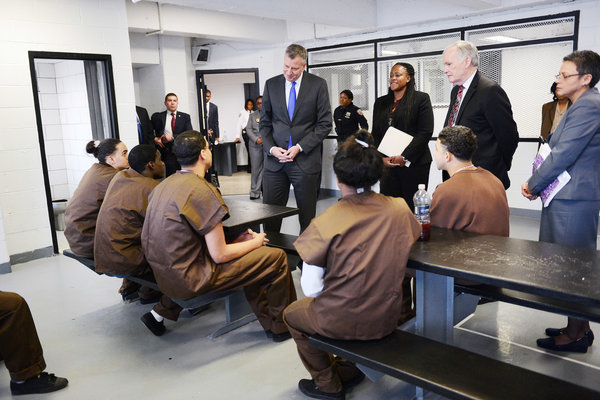
Mayor de Blasio and Commissioner Ponte at Rikers (photo: Susan Watts)
Rikers Island reached a new level of infamy last summer when a Department of Justice report detailed systemic violence and despicable mistreatment of inmates. Following that, shocking reports of abuse continued to emerge, validating a damning investigation and legal action by U.S. Attorney Preet Bharara. And now, in just the past month, we have seen both a report describing the lack of background checks during Rikers hiring practices, and news that healthcare complaints in New York's jails nearly doubled in two years.
After dropping a high-ranking Department of Correction official and appointing three new members to the watchdog Board of Correction months ago, New York City's new Correction Commissioner Joseph Ponte recently fired a captain and five guards tied to an inmate abuse case from 2012. It was also recently announced that New York would end its practice of putting adolescents under 21 in solitary confinement—a landmark decision in our jail system's troubled history.
That's all a good and necessary start down a long road. But the shake-up can't end there, To be sure, Rikers needs a transformative overhaul, but so does the oversight system that so badly failed to raise the flag on the atrocities at Rikers over the last few years. To do one without the other is to guarantee more failure.
Much attention has been focused on the deplorable acts that took place on Rikers. Equal attention, though, must be paid to understanding why the oversight system was so ineffective. Either a mayoral commission must be appointed to investigate, or, alternatively, the City Council must conduct its own exhaustive review.
While such a process is underway, quick changes should also be made within the existing oversight system.
The documented horrors were being committed at Rikers and there was nary a public word of concern from two – that's two – appointed inspectors general (IGs). In fact, the Department of Investigation (DOI), where the IGs are housed, found hundreds of incidents of previously undocumented violence, but did not make the findings public in any way that we at the Citizens Crime Commission can find, nor did it include them in a City submission to federal investigators.
The Board of Correction (BOC) – our civilian oversight body for jails – also has a responsibility to educate the public about wrongdoing at Rikers, and it could have done much more. To the BOC's credit, it did issue three condemning reports—one last year and two this year, including one just last month. The BOC even brought up the question of inmate violence at its meetings. But when there was no action from the department or City Hall, BOC should have been much more vocal and proactive.
Now, U.S. Attorney Bharara has made clear that he will move for federal oversight if a thorough overhaul at Rikers is slow to materialize. In response, the de Blasio Administration has pledged to make serious changes at the jail, and outlined a sensible plan of action. But how do we make sure those reforms are working? And that this doesn't happen again?
First, the City's Inspector General for the Department of Correction (DOC) must be more accountable and assigned new responsibilities.
The DOI commissioner is directed by law to turn over cases to an appropriate local prosecutor when IGs find potential criminal behavior, and the investigation which led to the findings was commissioned by the Mayor, the City Council, or DOI itself. Those referrals should also be reported monthly to the Council for review, and released to the public—as should the results of all DOC IG investigations. After all, as Supreme Court Justice Louis Brandeis famously pointed out, "sunlight is the best disinfectant."
Second, we must put BOC on the public stage, and give it stricter responsibilities. Right now, the Board receives and is tasked to evaluate all internal reports of abuse and wrongdoing at Rikers. Its reporting of these incidents and their findings, however, is largely at its own discretion. That's not independent oversight. BOC must therefore be required to issue regular reports on inmate conditions and complaints system-wide.
Critically, BOC must also be empowered to receive complaints of violence directly from inmates, and directed to establish a secure system for filing them which fully insulates inmates from retribution.
The current grievance system discourages reporting. It is primarily managed internally at the DOC, with little oversight. For example, allegations regarding staff-on-inmate non-sexual assault are referred to a commanding officer. Putting guards on notice that there is active, independent oversight may well make them think twice before engaging in violence.
We can also add real-time oversight by requiring corrections officers to wear body cameras when amongst the jail population. The NYPD is field-testing cameras now, and the same reasons for police to wear them – safety and accountability – clearly apply at Rikers. The Corrections Commissioner has said he will add CCTV cameras—but that's not enough coverage.
A Rikers with real oversight is the best way to ensure our jail doesn't continue to be a national embarrassment. There's no time to lose. If our City and State are serious about real reform, they will undertake a plan that locks down a better future at Rikers, not just a fix for today.
***
Richard Aborn is the president of the Citizens Crime Commission of New York City.
***
Have an op-ed idea or submission for Gotham Gazette? E-mail editor Ben Max: This email address is being protected from spambots. You need JavaScript enabled to view it.
Public-Private Partnership Preserves Homes for 2,000 New Yorkers
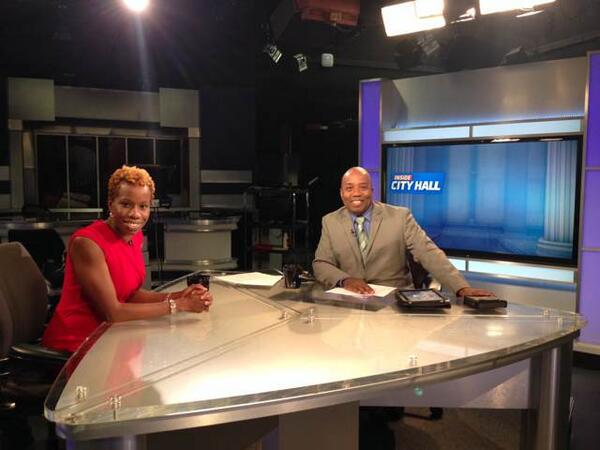
NYCHA Chair Shola Olatoye, the author, on Inside City Hall (photo: @NYCHA)
The New York City Housing Authority (NYCHA), home to more than 600,000 New Yorkers who live in public housing and Section 8 rentals, is the largest landlord in New York City and the largest public housing authority in the country. As federal support for public housing continues to decline and our properties continue to deteriorate, we must find creative ways to maintain and protect this vital resource for current and future generations.
To that end, NYCHA has formed a public-private partnership, Triborough Preservation Partners, which will provide $80 million in capital work for 875 units of Section 8 housing. Unlike NYCHA public housing, these properties are subsidized by Housing Assistance Payments from HUD. Steady reductions in HUD funding since 2001 has resulted in a deficit of more than $1 billion, making it impossible for NYCHA to keep up with critical repairs at all of its properties. In addition, the project-based Section 8 developments are ineligible for federal capital funding. This scarcity of funding has taken its toll – all told, the six developments need about $48 million of capital work over the next five years, and about $113 million over the next 15 years.
Limited government investment demands that we become creative about solutions to urgent problems, in particular, the infrastructure needs of our properties. Project-based Section 8 regulations allow NYCHA to partner with private entities to support capital repairs and rehabilitation without giving up our control or ownership of those properties. In fact, the affordable housing industry – and Public Housing Authorities in places like White Plains, St. Louis, and Miami – have leveraged private funds to preserve their buildings for residents for more than 30 years.
These project-based Section 8 units – located at Bronxchester Houses, Saratoga Square, Campos Plaza, Milbank-Frawley, East 4th Street, and East 120th Street – will remain Section 8 housing and are subject to rent stabilization regulations. NYCHA retains approval rights over major decisions. Under Section 8, residents' share of the rent will not increase – it will remain at 30 percent of their income.
Our trusted Triborough colleagues are experts in tenant-in-place rehab projects and will do everything possible to minimize the impact of renovation on residents. Repairs will include new kitchens and bathrooms for every apartment, renovated lobbies and community areas, energy-efficient technologies, and security enhancements. In the event that a resident must be relocated, the relocation will be temporary and at no cost to the resident. Additionally, Triborough has committed to training and hiring NYCHA residents for at least 20 percent of the construction work and 50 percent of the maintenance workforce for at least $15 an hour. So far, 21 NYCHA residents have been hired for these jobs.
In total, we expect this partnership to generate a return to NYCHA of approximately $360 million over the next 15 years, vital funds that helped close NYCHA's 2014 operating deficit and will fund capital work at our public housing developments as well.
This partnership is a win for everyone. Residents of the six developments will quickly benefit from completed repairs and enhanced living conditions. NYCHA residents across the five boroughs have another source of training and employment. New Yorkers can be assured that public housing – including project-based Section 8 housing – remains a valuable asset and a trusted resource for not just this generation, but also the next generation of New Yorkers.
At NYCHA we are committed to not just sustaining public housing for the future, but in making it better – not just painting over the problems, but creating safe, clean, and connected communities wherever there are NYCHA developments.
***
Shola Olatoye is Chair and CEO of NYCHA.
***
Have an op-ed idea or submission for Gotham Gazette? E-mail editor Ben Max: This email address is being protected from spambots. You need JavaScript enabled to view it.
Time to Pass the Homeless Protection Act
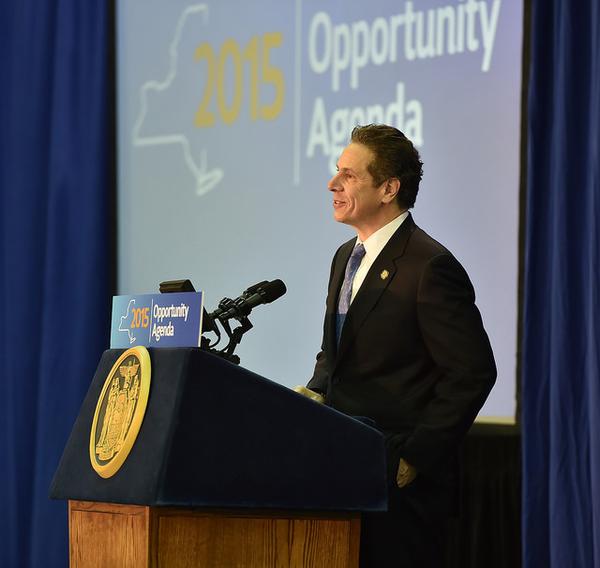
Gov. Cuomo outlining his 2015 agenda (photo: @NYGovCuomo)
On Saturday morning, in yet another example of the growing trend of attacks on homeless individuals, a traveler at the Newark Liberty International Airport beat a 62-year-old homeless man. The victim, a client in the Urban Pathways Newark Airport Outreach Program, was sleeping when he was attacked. The perpetrator put an innocent man in the hospital with serious injuries. He also potentially disrupted the trust and comfort that the victim developed during outreach, which is so critical to moving him from the street into housing.
Attacks like these against homeless persons appear to be growing in number and severity. In recent days, a homeless man sleeping under a New York City bridge reportedly had his mattress set afire. Last year, a homeless man sleeping on the steps of a Bronx church, a place he often slept because he told the priest that he felt safer at the church, was beaten to death. These are among hundreds of attacks on the homeless that occur each year.
As we work to help the homeless, among the most vulnerable in our society, find stable housing, we must also act to protect their well-being.
New York State should pass the "Homeless Protection Act" (A.1353 and S.813). Stalled in the Legislature for the past six years, the Act would designate certain offenses against the homeless as hate crimes, protecting them from future violence and abuse. Passing the legislation could also raise consciousness about the stigmatization problem at the heart of this issue. If the number of attacks are as high as advocates contend, statistics will open eyes and hopefully cause a long overdue response, further helping homeless individuals move off the streets and into self-sufficiency.
Organizations across the New York City metropolitan area, such as Urban Pathways and Care for the Homeless, provide outreach services to the street homeless, attempting to engage the most difficult to reach. Outreach staff engage homeless individuals on the streets and at transit hubs, "where they are at," and offer case management and referrals to move individuals from the street into housing and treatment programs in order to minimize the chance of a return to the streets.
For the past 15 years, the National Coalition for the Homeless has issued an annual report, documenting the increasingly frequent and severe violence against the homeless by housed individuals. The Coalition report, largely based on media reports, recorded 1,437 attacks and 357 deaths nationally from 2009 to 2013. Precise data on the attacks doesn't exist, since they are often not reported or when reported, not recorded. Attacks as extreme as setting a victim on fire, and videotaping attacks to post online, only further encourage the mistreatment of the homeless.
Homeless people, or those perceived as homeless, are not usually targeted for robbery; they have too few monetary resources for that. According to the Coalition report, perpetrators either have no explanation for the attack or claim they attacked those so in need because they were so vulnerable – so easy – to victimize. Homeless advocates and social scientists often cite "stigmatization" as the base cause. In the ultimate "blame the victim" phenomenon, the poorest among us, are further stigmatized and dehumanized.
A national effort to address this disturbing trend in attacks against the homeless is underway. Poverty and social justice advocates are working to include people attacked because they are homeless, or perceived to be homeless, under hate crime laws. In January, Cincinnati became the third U.S. city to provide hate crimes protection to the homeless. New York State can and must make a major statement by passing the Homeless Protection Act this year.
***
Nicole Bramstedt is the Policy Analyst at Urban Pathways and Jeff Foreman is Policy Director at Care for the Homeless.
***
Have an op-ed idea or submission for Gotham Gazette? E-mail editor Ben Max: This email address is being protected from spambots. You need JavaScript enabled to view it.
'Broken Windows:' Immoral, Ineffective, & Out of Time
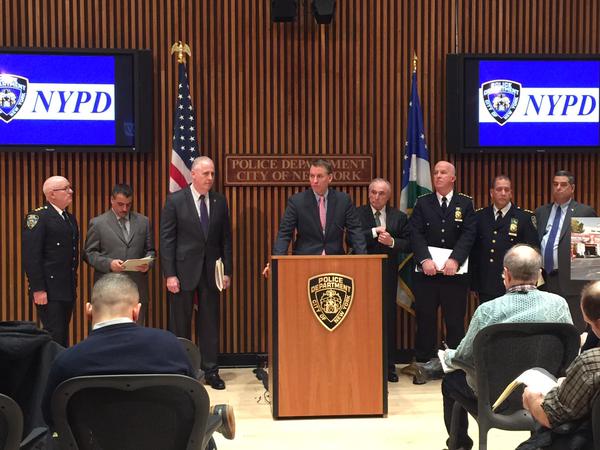
NYPD leaders discuss crime (photo: @NYPDNews)
Even with the publicized results of the recent work slowdown by officers — cops stopped arresting and ticketing people for minor infractions and crime went into a steep decline — Mayor de Blasio continues to defend 'broken windows' policing. A serious moral and political lapse by the city's most progressive mayor in at least 20 years.
The NYPD's quota-driven, 'broken windows' practices target low-level, often innocuous activities like carrying an open alcohol container, walking between subway cars, begging, and jaywalking. A mockery of justice, now exposed in an "emperor has no clothes" moment as ineffective, 'broken windows' policing everyday inflicts harm and hardship on hundreds, if not thousands, mostly low-income people of color. This stark racial bias which includes the aggressive bullying of marginalized groups like the homeless, sex workers, the mentally ill, street vendors, and LGBT youth prevails without, for the most part, organized opposition or outcry from any quarter, including the good people working within the system. Relevant are the telling words from Martin Luther King Jr., whose birthday we just celebrated: "In the end we will remember most not the voices of our enemies but the silence of our friends."
The daily racial bias and injustice of the system is undeniable. Here are sample statistics that we have culled from the NYPD and other government agencies that indicate how 'broken windows' is enforced and why it must end:
-From 2008-2011, the police issued an average of eight bike-on-the-sidewalk summonses in Park Slope, Brooklyn. During the same time period, for these kinds of tickets the annual average in Bedford-Stuyvesant, Brooklyn was 2,050.
-For the first 9 months of 2014, the NYPD made 174,823 misdemeanor arrests (648 per day), 86.2 percent involving people of color. Despite the fact that a new administration began in 2014, these figures represent a remarkably similar pattern to the arrest practices of the same span in 2013 when the numbers were 173,625 arrests, 87% involving people of color.
-95 percent of the people incarcerated on Rikers Island are black or Hispanic, confined because of two main factors: the NYPD arrested and locked them up; and they were too poor to make bail.
-In 2011, the height of the NYPD's use of stop-and-frisk, black and Hispanic males between the ages of 14 and 24 accounted for 41.6 percent of stops even though they are only 4.7 percent of the city's population. The number of stops of young black men in 2011 exceeded the entire city population of young black men — 168,126 stops compared to 158,406 people.
Compounding the harm done by 'broken windows' policing are the collateral consequences of these petty arrests and summonses: loss of one's job or time at work, denial of access to scholarships or public housing, loss of child custody, even deportation in some cases. More than any current government policy or practice, 'broken windows' causes and reflects the everyday social, economic, and racial inequities that afflict our city. 'Broken windows' policing and its consequences represent "a tale of two cities" writ large.
New York City cannot have two different criminal justice systems.
The significance of now, of this moment is that it is the first time in the city's history that the issue of abusive and biased policing is front and center in the political landscape and the policy debate. Previous outcries focused on egregious incidents of police brutality and excessive force such as the shooting deaths of Amadou Diallo and Sean Bell. Never before has there been a sustained and highly visible movement aimed at exposing and correcting the daily systemic practices that compromise the lives and well-being of people, practices that serve to devalue the worth and lives of black and Hispanic people and create the circumstances wherein it is inevitable that fatalities occur at the hands of police officers.
In sum, here's the bad news: these terrible and unjustifiable practices have persisted for decades, are indisputably racist and deeply immoral, represent a dark stain on our city's legacy and question its reputation as a diverse and welcoming metropolis.
But here's the good news for Mayor de Blasio and the rest of us: because of the growing attention on this issue; because more and more people outside the community most often victimized are aware of abusive policing and its widespread ill effect;, because the affected constituency is actively mobilized in the movement for sweeping reforms; and because the NYPD work slowdown has exposed the myth of 'broken windows' as a successful crime reduction strategy — all unprecedented developments — New York City has an historic opportunity to fully redress long-standing injustices and to create public safety measures that bring together community groups, public and non-profit service providers, and law enforcement, and that make significant progress toward establishing a truly inclusive and equitable city. The first step is an end to 'broken windows.'
***
Robert Gangi is the director of the Police Reform Organizing Project (PROP). Find PROP online at its website and on Facebook and Twitter.
***
Have an op-ed idea or submission for Gotham Gazette? E-mail editor Ben Max: This email address is being protected from spambots. You need JavaScript enabled to view it.
The Bill Cosby of Albany
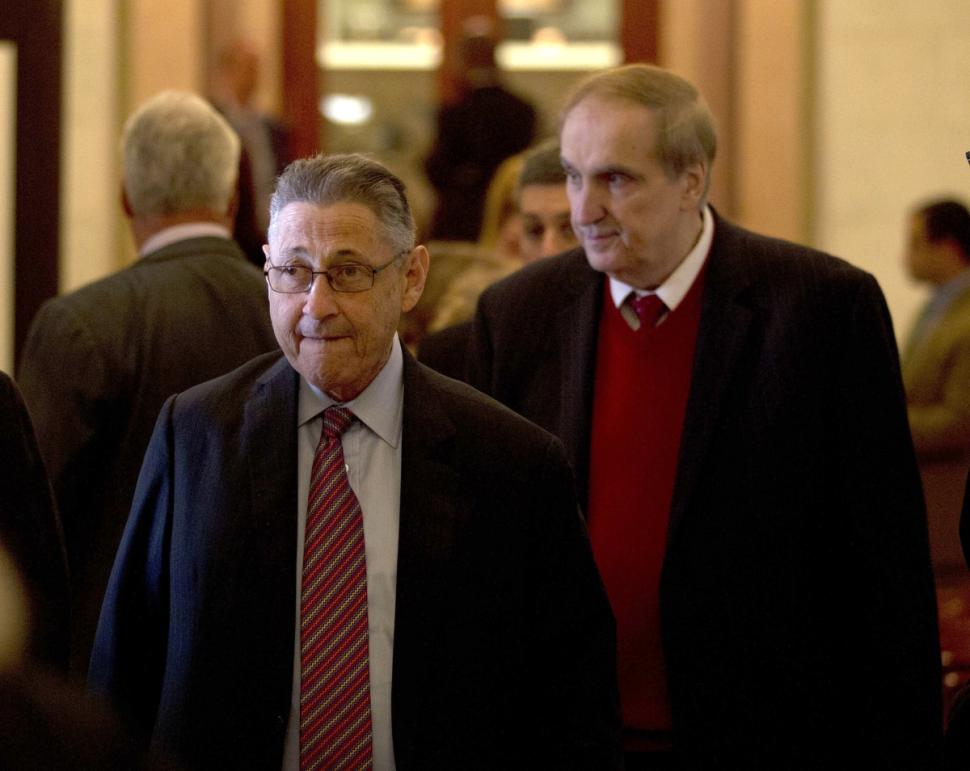
Sheldon Silver, foreground, and Vito Lopez (photo: AP/Mike Groll)
Since Sheldon Silver's downfall, various members of the Assembly have expressed tears and praise for a man whose progressive politics allowed his supporters to forgive all manner of sin. What's a few broken and brutalized women compared to a choice committee, or a successful bill?
As supporters sentimentalize a man who systematically protected sexual predators over female staff, Silver's legacy comes into horrifying relief: women are expendable for the right policy agenda.
"It's horse-trading with someone's humanity," commented one of several victims of sexual harassment in the Assembly, who spoke on the condition of anonymity.
Silver was first elected to the Assembly in 1976, the same year Bill Cosby allegedly drugged and raped Theresa Serignese, one of three dozen women who recently came forward after decades of silence. While an evolving social intolerance finally ended Cosby's career, Silver's flourished despite a repeated indifference to rape, assault, and sexual harassment of Assembly staff. When the once powerful Speaker was finally ousted last week, it was not for strong-arming victims into settlements and gagging them with confidentiality clauses. No, in fact Silver is still being sued because a judge found that former Assembly Member Vito Lopez's second set of victims "have a plausible claim that Silver participated in and caused the deprivation of their rights."
Unsurprisingly, a 2013 Quinnipiac poll found that 58% of New Yorkers wouldn't want their daughter to be an intern in the State Legislature.
But the Cosby effect has yet to hit Albany. Since 2003 when Elizabeth Crothers first reported being raped by Silver's aide Michael Boxley, the chamber has been all too happy to let the Speaker deny women their rights, and degrade them further in the process. Boxley himself has survived thanks to Silver's support and the culture of indifference, but only after allegedly raping a second woman and pleading to a lesser charge. He's now a lobbyist in Albany at Brown and Weinraub. In 2012, a deluge of media reports revealed the disturbing details of Lopez's serial predation and the outrageous lengths to which Speaker Silver went to cover it up. And still, members were willing to defend Silver, eject Lopez, and carry on.
In lamenting the Speaker's eventual fall from grace, the otherwise outstanding Chair of the Assembly Health Committee, Richard Gottfried, explained the calculation thus: "There is no one in public life in New York who has fought more effectively, for decades, for almost everything I care about in public policy than Sheldon Silver."
This is the same kind of justification that Cosby's defenders, like Phylicia Rashad, use to excuse the violence and terror he allegedly inflicted on 35 women: "What you're seeing is the destruction of a legacy. And it's a legacy that is so important to the culture."
Where does that leave the women who were brave enough to stand up for themselves, and the potential others who never could?
"I am angry but I am also tired of being angry at the obscene injustice of New York's calls for fair and equal treatment falling on deaf ears in Albany," one victim derided. "I feel deserted"
"You'd think now that he's no longer in power what are people afraid of?" wondered another.
Indeed. Why continue the charade of standing by the Speaker now that he's gone?
Like Cosby, Silver's legacy is inextricably linked to his callous disregard for the women who needed his protection. But the Assembly's doesn't have to be. It's time to end the charade and acknowledge the full reality of Silver's tenure: there is no amount of political rights which can excuse his grievous wrongs.
***
Alexis Grenell is a Democratic political strategist, she writes a regular column for City & State. You can find her on Twitter @agrenell.
***
Have an op-ed idea or submission for Gotham Gazette? E-mail editor Ben Max: This email address is being protected from spambots. You need JavaScript enabled to view it.




